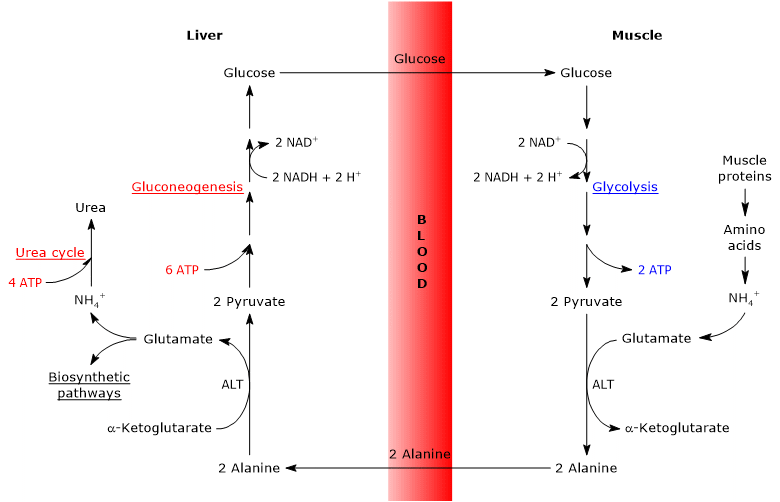The Synthesis of Glucose From Certain Amino Acids Involves
The biosynthesis of serine and glycine constitute a major metabolic pathway that plays a central role in the formation of other amino acids nucleic acids and phospholipids. What involved in the synthesis of glucose from certain amino.

Gluconeogenesis An Overview Sciencedirect Topics
Choose the correct statement about nutrient synthesis Lipogenesis occurs when an individual consumes excess fat Gluconeogenesis involves the synthesis of glucose from carbohydrate substrates Nonessential amino acids NEM can be synthesized from carbohydrate or fat metabolic Intermediates when adequate energy and nitrogen are present in the body.

. The synthesis of glucose from certain amino acids involves. Proteins lipids and nucleic acids Fig. The regulation of protein synthesis is an important part of the regulation of gene expression.
373574 What is involved in the synthesis of glucose from certain amino acids. Tyrosine is synthesized by the hydroxylation of phenylalanine an essential amino acid. Amino acids are involved in synthesizing three primary macromolecules.
Formation of ammonia incorporation of ammonia in an organic compound generally in the form of glutamic acid synthesis of the carbon skeleton of amino acids ie. What is the synthesis of glucose from amino acids called Gluconeogenesis. Glucose is made from pyruvate lactate glycerol glycerate 3-phosphate and amino acids and the process is called gluconeogenesis.
The synthesis of amino acids can be divided in several steps. Gluconeogenesis supplies the needs for plasma glucose between meals. The major substrates for gluconeogenesis include lactate pyruvate propionate glycerol and 18 of the 20 amino acids the exceptions are leucine and lysine.
The process of glycogenesis is the reverse of gluconeogenesis which synthesizes glucose from other amino acids. It occurs in all microorganisms fungi plants and animals and the reactions are essentially the same leading to the synthesis of one glucose molecule from two pyruvate molecules. Proline and arginine are derived from glutamate.
The synthesis of glucose from certain amino acids involves-deamination-transcription-translation-transamination. The energy from burning them is used to make the new glucose. Glucose cannot be synthesized from fatty acids since they are converted by β-oxidation into acetyl coenzyme A CoA which subsequently enters the citric acid cycle and is oxidized to CO 2.
What is involved in the synthesis of glucose from certain amino acids. The results suggest that the postprandial rise in glucose independently of insulin and amino acids stimulates protein synthesis in neonates and this. It is sometimes called NeoglucogenesisIt is a ubiquitous or universal pathway which occurs in humans animals plants fungi and other living organisms.
The regulatory volume decrease mechanism explaining these effects was defined by Meijer et al. When glycogen stores are depleted in muscle during exertion and liver during fasting catabolism of muscle proteins to amino acids contributes the major source of carbon for maintenance of blood glucose levels. Raising glucose insulin and amino acids increased protein synthesis in most tissues.
All 20 canonical amino acids are proteinogenic but only a subset of amino acids is involved in nonessential amino acid NEAA synthesis eg glutamine glutamate methionine and phenylalanine. Gluconeogenesis has only three irreversible steps opposite. Like glycolysis and gluconeogenesis glycogenolysis and glycogenesis are NOT reversals of each other.
Answer 1 of 2. The liver is a so-called altruistic organ which releases glucose into the blood to meet tissue need. Glucose released from muscle glycogen stores is used on site to provide energy for muscle contraction.
Once burned the atoms fr. Coliis grown on glucose fully 15 of carbon assimilated passes through the serine pathway. In addition to generating energy for normal metabolism this also allows certain cells and organelles in our body to store large amounts of glucose that can be used during periods where fat cannot supply enough fuel.
It involves amino acid-induced swelling of hepatocytes resulting in loss of chloride ions which leads to deinhibition of glycogen synthase phosphatase. Gluconeogenesis occurs in a reverse manner of glycolysis which produces glucose by the precursors like pyruvate lactate glucogenic amino acids. Regulation of mRNA translation controls the levels of particular proteins that are synthesized upon demand such as synthesis of the different chains of globin in hemoglobin or the production of insulin from stored insulin mRNAs in response to blood glucose levels to.
They include alanine asparagine arginine aspartic acid glutamic acid cysteine glutamine proline glycine serine and tyrosine. Gluconeogenesis is a metabolic pathway that leads to the synthesis of glucose from pyruvate and other non-carbohydrate precursors even in non-photosynthetic organisms. Apart from these there are other nine amino acids which are very much essential as they cannot be synthesized by our body.
Gluconeogenic substrates include glycerol lactate propionate and certain amino acids. Formation of the corresponding α-keto acids and lastly transfer of the amino group from the glutamic acid to these various α-keto acids by. The amino acid atoms arent literally used to make the new glucose.
Certain amino acids stimulate glycogenesis from glucose. Of all the amino acids utilized for gluconeogenesis glutamine is the most important as this amino acid is critical for glucose production by the kidneys and small intestine. The three-carbon fatty acid.
Gluconeogenesis is stimulated by the diabetogenic hormones glucagon growth hormone epinephrine and cortisol. The word parts add up to making new glucose. Glutamine is synthesized from NH4 and glutamate and asparagine is synthesized similarly.
The response in muscle was associated with phosphorylation of PKB mTOR S6K1 and 4E-BP1 and enhanced eIF4EeIF4G formation. Serine formed from 3-phosphoglycerate is the precursor of glycine and cysteine. Gluconeogenesis occurs in the liver and kidneys.
Gluconeogenesis converts pyruvate to glucose-6-phosphate through a series of intermediates many of which are shared with glycolysis. Out of 20 amino acids our body can easily synthesize a few on its own and are called non-essential amino acids.

Gluconeogenesis An Overview Sciencedirect Topics

6 42 Gluconeogenesis Nutrition Flexbook

Glucose Alanine Cycle Definition Steps Reactions Tuscany Diet
0 Response to "The Synthesis of Glucose From Certain Amino Acids Involves"
Post a Comment